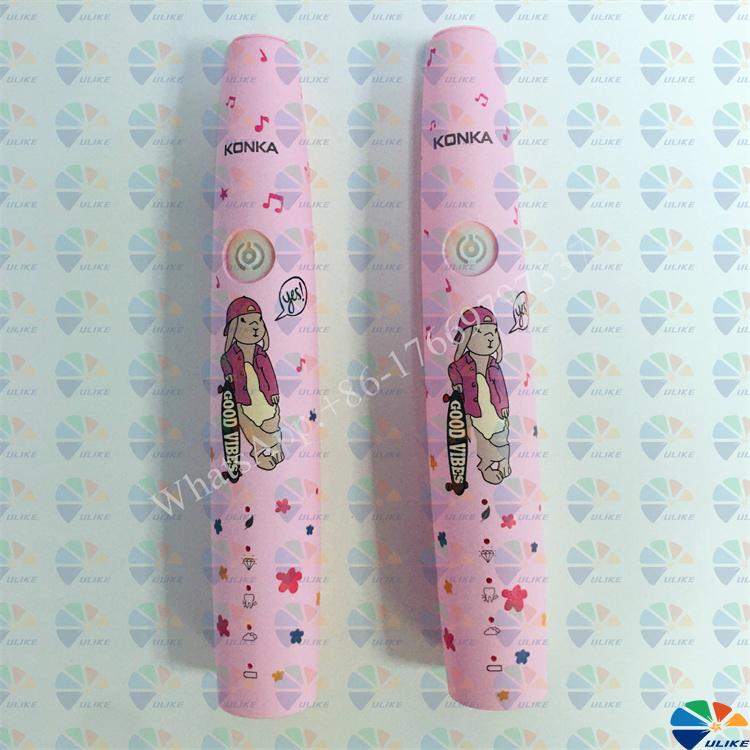A powerful printing process, thermal transfer vs. silk screen and pad printing
A powerful printing process,
thermal transfer vs. silk screen and pad printing
1 Definition of thermal transfer, silk screen and pad printing
What is thermal transfer?
Thermal transfer is a new printing method that transfers the pattern on the transfer film to the surface of the substrate by heating and pressurizing. Process: Thermal transfer is to make a plate first, then make a thermal transfer film, and finally print the pattern on the film on the product. It works through the medium of the film.
What is silk screen printing?
Silk screen printing is a printing method that transfers ink through the holes of the orifice plate to the substrate through pressure. The process principle of silk screen printing: first make a plate, mainly a paper film plate or other plate, and make holes on the plate base to pass the ink; then use the scraper to squeeze, that is, pressure, to transfer the ink on the plate through the mesh to the product to form a pattern.
What is pad printing?
Pad printing is a special printing method that uses a pad printing head to dip the ink on the gravure plate and press it on the surface of the product to form a pattern.
2 Advantages of thermal transfer, screen printing and pad printing
Advantages of thermal transfer
Thermal transfer can achieve printing on relatively regular surfaces such as flat surfaces, curved surfaces and conical surfaces;
The printing speed is fast, the material loss is extremely low, and it is suitable for large-scale product printing;
The printed pattern is exquisite and the color reproduction performance is excellent;
No noise or odor pollution, which greatly promotes environmental protection;
After printing, it can be packaged, which greatly improves work efficiency and saves the time required for other printing to "wait for drying", and also saves the space required for other printing to "wait for drying".
Advantages of screen printing
It can achieve printing on relatively soft substrates (such as soft PVC, textiles, etc.),
It can print substrates with a large area (the largest substrate can reach 200mm*100mm),
The printing ink layer is relatively thick, the covering power is good, and it can print relatively exquisite patterns. The plate making fee is low.
Advantages of pad printing
The printing speed is relatively fast and the material loss is low. The plate-making fee is low;
Printing can be achieved on a very small plane;
Printing can be achieved on irregular surfaces, such as on workpieces with large surface bumps.
3 Disadvantages of thermal transfer, silk screen printing, and pad printing
Disadvantages of thermal transfer
Due to the excellent color reproduction performance of the thermal transfer film, it is necessary to make a high-precision gravure plate to achieve printing, and the gravure plate making cycle is relatively long (one week), and the plate-making fee is relatively high.
Disadvantages of silk screen printing
The odor is very strong, and there are considerable disadvantages in terms of environmental protection; the workpiece after silk screen printing needs a drying process, and a certain place is required to place the printed workpiece; the pattern will have printing problems such as drawing and burrs
Material loss is large.
Disadvantages of pad printing
The odor is very strong, and there are disadvantages in terms of environmental protection;
The workpiece after pad printing needs a drying process, and a certain place is required to place the printed workpiece;
The printed pattern can only be a relatively simple single color or a few colors, and it is impossible to print exquisite patterns,
The pattern will have printing problems such as drawing and burrs. Large-area printing cannot be achieved.

![af]() Afrikaans
Afrikaans![sq]() Albanian
Albanian![am]() Amharic
Amharic![ar]() Arabic
Arabic![fr]() French
French![es]() Spanish
Spanish![ru]() Russian
Russian![de]() German
German![hy]() Armenian
Armenian![it]() Italian
Italian![ja]() Japanese
Japanese![ko]() Korean
Korean![pt]() Portuguese
Portuguese![hi]() Hindi
Hindi![az]() Azerbaijani
Azerbaijani![ro]() Romanian
Romanian![pl]() Polish
Polish![th]() Thai
Thai![el]() Greek
Greek![eu]() Basque
Basque![en]() English
English![zh-CN]() Chinese (Simplified)
Chinese (Simplified)![zh-TW]() Chinese (Traditional)
Chinese (Traditional)![be]() Belarusian
Belarusian![bn]() Bengali
Bengali![bs]() Bosnian
Bosnian![bg]() Bulgarian
Bulgarian![ca]() Catalan
Catalan![ceb]() Cebuano
Cebuano![ny]() Chichewa
Chichewa![co]() Corsican
Corsican![hr]() Croatian
Croatian![cs]() Czech
Czech![da]() Danish
Danish![nl]() Dutch
Dutch![eo]() Esperanto
Esperanto![et]() Estonian
Estonian![tl]() Filipino
Filipino![fi]() Finnish
Finnish![fy]() Frisian
Frisian![gl]() Galician
Galician![ka]() Georgian
Georgian![gu]() Gujarati
Gujarati![ht]() Haitian Creole
Haitian Creole![ha]() Hausa
Hausa![haw]() Hawaiian
Hawaiian![iw]() Hebrew
Hebrew![hmn]() Hmong
Hmong![hu]() Hungarian
Hungarian![is]() Icelandic
Icelandic![ig]() Igbo
Igbo![id]() Indonesian
Indonesian![ga]() Irish
Irish![jw]() Javanese
Javanese![kn]() Kannada
Kannada![kk]() Kazakh
Kazakh![km]() Khmer
Khmer![ku]() Kurdish (Kurmanji)
Kurdish (Kurmanji)![ky]() Kyrgyz
Kyrgyz![lo]() Lao
Lao![la]() Latin
Latin![lv]() Latvian
Latvian![lt]() Lithuanian
Lithuanian![lb]() Luxembourgish
Luxembourgish![mk]() Macedonian
Macedonian![mg]() Malagasy
Malagasy![ms]() Malay
Malay![ml]() Malayalam
Malayalam![mt]() Maltese
Maltese![mi]() Maori
Maori![mr]() Marathi
Marathi![mn]() Mongolian
Mongolian![my]() Myanmar (Burmese)
Myanmar (Burmese)![ne]() Nepali
Nepali![no]() Norwegian
Norwegian![ps]() Pashto
Pashto![fa]() Persian
Persian![pa]() Punjabi
Punjabi![sm]() Samoan
Samoan![gd]() Scottish Gaelic
Scottish Gaelic![sr]() Serbian
Serbian![st]() Sesotho
Sesotho![sn]() Shona
Shona![sd]() Sindhi
Sindhi![si]() Sinhala
Sinhala![sk]() Slovak
Slovak![sl]() Slovenian
Slovenian![so]() Somali
Somali![su]() Sudanese
Sudanese![sw]() Swahili
Swahili![sv]() Swedish
Swedish![tg]() Tajik
Tajik![ta]() Tamil
Tamil![te]() Telugu
Telugu![tr]() Turkish
Turkish![uk]() Ukrainian
Ukrainian![ur]() Urdu
Urdu![uz]() Uzbek
Uzbek![vi]() Vietnamese
Vietnamese![cy]() Welsh
Welsh![xh]() Xhosa
Xhosa![yi]() Yiddish
Yiddish![yo]() Yoruba
Yoruba![zu]() Zulu
Zulu


